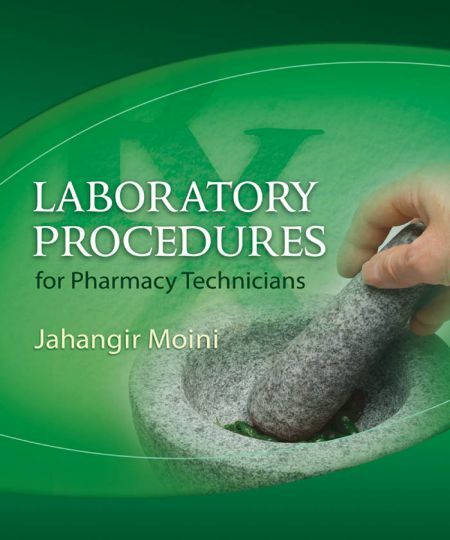Laboratory Procedures for Pharmacy Technicians by Jahangir Moini. This book is organized into two parts, “Theory Review and Procedures,” and “Self-Evaluation.”
Laboratory Procedures for Pharmacy Technicians
 Compounding is one of the major tasks of pharmacy technicians. Non sterile compounding is one of the most challenging activities in the pharmacy and pharmacy technicians must have specific education and training in this area. This textbook provides students with hands-on, step-by-step procedures that they will find essential for laboratory work. Prior study of anatomy, physiology, chemistry, and pathology is helpful in understanding the skills that are taught in this textbook. Key principles of laboratory activities are described in this text, as well as explanation of equipment and the laboratory environment.
Compounding is one of the major tasks of pharmacy technicians. Non sterile compounding is one of the most challenging activities in the pharmacy and pharmacy technicians must have specific education and training in this area. This textbook provides students with hands-on, step-by-step procedures that they will find essential for laboratory work. Prior study of anatomy, physiology, chemistry, and pathology is helpful in understanding the skills that are taught in this textbook. Key principles of laboratory activities are described in this text, as well as explanation of equipment and the laboratory environment.
This book is organized into two parts, “Theory Review and Procedures,” and “Self-Evaluation.” The first part consists of three sections, “General Concepts,” “Non sterile Compounding Products,” and “Sterile Compounding Products,” which collectively contain eleven chapters. Th e Self-Evaluation part of this book features one test for each of the three sections found in Part One. Following Part Two is an answer key, appendices, a glossary, and an index.
Each chapter contains an outline of the key topics, objectives that the student must be able to meet upon completion of the reading, and a list of key terms (which are bolded in the chapter text). Overviews serve to introduce the student to the key concepts of the chapter. Figures serve to accurately illustrate chapter principles and related information. Accurate tables focus on essential information that must be fully understood in order to master each chapter’s content. Step-by-step procedures are listed which correspond to the figures to show equipment, materials to be handled, and actual tasks. Special “Alert” features are distributed throughout each chapter, highlighting key information. Chapter summaries serve to reinforce the chapter content and focus on key ideas from the text.
At the end of each chapter, review questions are given that help students to test the knowledge they have gained from their reading. Th e questions are given in a variety of formats to encourage more complete comprehension. Lab activities are listed so that students may practice their skills. Book and Web site references are given so that students may seek out additional information to complement their studies. Th e answer key to each chapter’s review questions is also provided.
Password: pdflibrary.net
